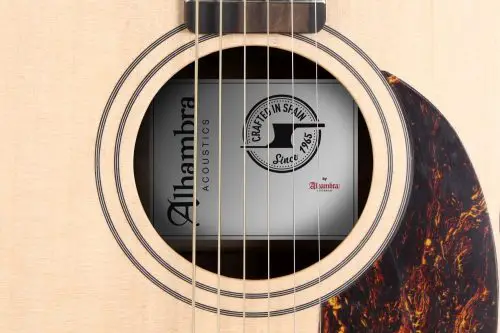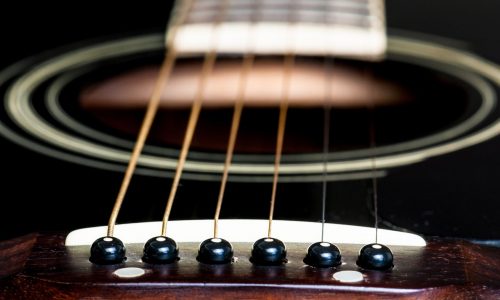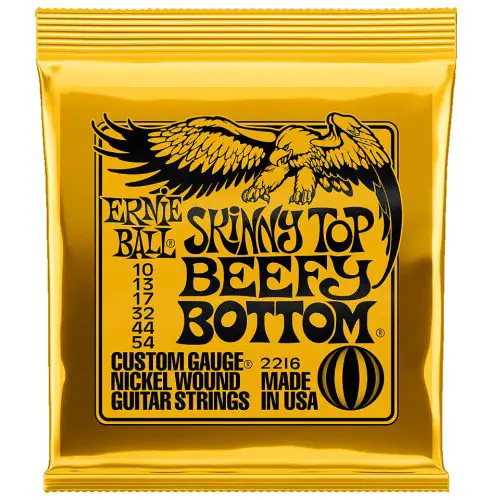The best string gauge for an acoustic guitar largely depends on personal preference and the style of music you play. Lighter gauge strings are easier to play and provide a brighter tone, while heavier gauge strings offer more volume and a fuller sound.
The most common string gauges for acoustic guitars are light, medium, and heavy. Light gauge strings typically range from .010 to .052, medium gauge strings range from .011 to .056, and heavy gauge strings range from .012 to .058.
Light Gauge Strings:
Light gauge strings are ideal for beginners and players who prefer a lighter touch. They are easier to fret and bend, making them ideal for playing lead guitar or intricate fingerstyle patterns.
Light gauge strings also produce a bright and crisp tone, which is well-suited for genres such as pop, folk, and country. However, they may lack the volume and depth that heavier gauge strings offer.
Medium Gauge Strings:
Medium gauge strings are a popular choice for most acoustic guitarists. They strike a balance between playability and tone. The slightly thicker gauge provides more projection and a fuller sound compared to light gauge strings.
Medium gauge strings are suitable for a wide range of musical styles, including rock, blues, jazz, and acoustic singer-songwriter genres.
Heavy Gauge Strings:
Heavy gauge strings are favored by players who prefer a robust and powerful sound. They offer increased volume, sustain, and resonance. Heavy gauge strings are often used in styles such as bluegrass, country, and heavy strumming.
However, they can be more challenging to play due to the increased tension on the guitar’s neck and body. They also require more finger strength, making them less suitable for beginners or players with smaller hands.
When choosing the best string gauge for your acoustic guitar, it’s important to consider factors such as playing style, finger strength, and musical genre. Experimentation may be necessary to find the perfect balance between playability and tone.
It’s also worth noting that the type of strings (e.g., steel, bronze) and the construction of your guitar can also influence the overall sound and feel. Ultimately, selecting the right string gauge is a personal choice that can greatly enhance your playing experience.
Here is a summary table highlighting the different string gauge options for acoustic guitar:
| String Gauge | Advantages | Disadvantages | Recommended for |
|---|---|---|---|
| Light Gauge | – Easier to play – Bright and crisp tone |
– Reduced volume and projection – Decreased sustain |
– Fingerstyle playing – Pop, folk, and country genres |
| Medium Gauge | – Balance between playability and tone – Fuller sound |
– Less volume compared to heavy gauge – Not as easy to play as light gauge |
– Versatile option for various playing styles |
| Heavy Gauge | – Increased volume and resonance – Robust and powerful sound |
– More challenging to play – Requires more finger strength |
– Bluegrass, country, and heavy strumming |
| Medium-Light/Medium-Heavy Gauge | – Enhanced volume and sustain – Strong midrange response |
– Not as easy to play as light gauge – Tension on the guitar’s neck and body |
– Players seeking a balance between playability and tone |
Please note that this table provides a general overview, and individual preferences may vary. It’s essential to consider factors like playing style, musical genre, and personal comfort when choosing the best string gauge for your acoustic guitar.
Also Read: Beginner’s Guide: The Easiest String Gauge for Your Guitar
What gauge strings is most common for acoustic guitar?
The most common string gauge for acoustic guitars is medium gauge. Medium gauge strings typically range from .011 to .056. They strike a balance between playability and tone, making them a popular choice among guitarists.
Medium gauge strings offer a good combination of ease of play and a rich, full sound. They provide enough tension to produce volume and projection, while still being comfortable to play. The slightly thicker gauge compared to light strings gives them a more substantial feel, making them suitable for a wide range of playing styles and genres.
One advantage of using medium gauge strings is their versatility. They work well for strumming, fingerpicking, and lead playing. Whether you’re playing rock, blues, folk, jazz, or acoustic singer-songwriter music, medium gauge strings can accommodate your playing style.
Moreover, choosing medium gauge strings allows you to achieve a balanced tonal spectrum. They provide a warm and full-bodied sound with a good amount of brightness and clarity. This tonal balance makes medium gauge strings a popular choice for recording and live performances alike.
However, it’s worth noting that the choice of string gauge ultimately depends on personal preference and playing style. Some guitarists may prefer the playability and brightness of light gauge strings, while others may opt for the volume and depth of heavy gauge strings. It’s essential to try out different gauge options to find what works best for you and your acoustic guitar.
Additionally, factors like the type of strings (steel or bronze) and the specific construction of your guitar can also influence the sound and feel. For instance, a guitar with a larger body may benefit from the added resonance and projection provided by medium gauge strings.
Thicker vs thinner string gauge for acoustic guitar

Thicker gauge has more volume but lighter is easier to play
When it comes to choosing between thicker and thinner string gauges for an acoustic guitar, it’s important to consider the impact on playability and tone. Thicker gauge strings offer more volume, sustain, and a fuller sound, while thinner gauge strings are easier to play and provide a brighter tone.
Thicker gauge strings, such as heavy gauge or medium-heavy gauge, are favored by players who prioritize a powerful, robust sound. These strings require more finger strength and can be more challenging to play, especially for beginners or those with smaller hands.
However, the greater tension and mass of thicker strings result in increased volume and resonance. They are often preferred by players of genres like bluegrass, country, and heavy strumming. Thicker strings can provide a rich, deep bass response and a stronger midrange presence.
On the other hand, thinner gauge strings, like light or medium-light gauge, are popular among players who prioritize ease of play and a brighter, more articulate tone. They are easier to fret and bend, making them suitable for intricate fingerstyle playing or lead guitar work.
Thinner strings also tend to have a more pronounced treble response and can produce a clearer and more sparkly sound. They are often preferred for genres like pop, folk, and country.
Ultimately, the choice between thicker and thinner string gauges depends on personal preference and playing style. Many guitarists find that a middle-ground gauge, such as medium gauge, offers a good compromise between playability and tone. However, it’s worth exploring different gauge options to find what suits your style best. Remember that the type of strings (steel or bronze) and the construction of your guitar can also influence the overall sound and feel.
Experimenting with different string gauges can be an enlightening experience, as it allows you to discover the nuances and possibilities that each gauge offers. Consider factors such as your playing style, finger strength, and musical genre when making your decision.
Remember that it’s also essential to properly set up your guitar and adjust the truss rod to accommodate the specific tension requirements of your chosen string gauge.
Also Read: String Gauge Influence on Guitar Sound: Lighter vs. Heavier
What string gauge is best for strumming?

When it comes to strumming on an acoustic guitar, lighter gauge strings are generally favored due to their easier playability and brighter tone.
Light gauge strings, typically ranging from .010 to .052, are well-suited for strumming because they require less finger strength and effort to produce sound. These strings are easier to press down and bend, allowing for smoother and more fluid strumming motions. They are ideal for players who engage in vigorous strumming patterns or those who prefer a lighter touch on the strings.
In terms of tone, light gauge strings offer a brighter and more responsive sound that complements strumming techniques. They produce a clear and crisp tone that can help individual notes within strummed chords to stand out. This bright tone can be particularly well-suited for genres like pop, folk, and country, where an emphasis on rhythm and chordal accompaniment is prevalent.
However, it’s important to note that the choice of string gauge for strumming is subjective and can vary depending on personal preference and the specific sound you want to achieve. Some players may prefer slightly heavier gauge strings, such as medium-light or medium gauge, as they offer a slightly fuller sound and increased projection.
These gauges may provide a more balanced tonal response and can be well-suited for strumming in genres like rock, blues, or acoustic singer-songwriter styles.
Finding the best string gauge for strumming requires experimentation and finding the right balance between playability and tone. Consider factors like your playing style, desired sound, and the specific requirements of your guitar. Keep in mind that the type of strings (steel or bronze) and the construction of your guitar can also impact the overall feel and sound.
Pros & Cons of using heavier gauge strings for acoustic guitar
Pros:
- Increased Volume and Projection: Heavier gauge strings offer more tension for enhanced energy transfer to the soundboard. This results in a louder and resonant sound, which is ideal for live performances and allows your playing to cut through a mix.
- Enhanced Sustain: Thicker strings vibrate for a longer duration, leading to clearer and more enduring notes. This adds depth and richness to your guitar’s sound, making it more expressive and captivating.
- Stronger Midrange Response: Heavier strings emphasize midrange frequencies, contributing to better clarity in band mixes. They are particularly well-suited for genres like bluegrass and country, where powerful strumming or flatpicking is essential.
Cons:
- Requires Finger Strength: Using heavier strings requires more finger strength, which might be challenging for players with a lighter touch. Performing bends and intricate techniques could pose difficulties for some individuals.
- Stresses on Guitar’s Neck and Body: The increased tension from heavier strings can potentially stress the guitar’s neck and body. This stress could lead to issues such as neck bowing or bridge lifting. It’s crucial to ensure proper setup to mitigate these problems and maintain the guitar’s integrity.
Also Read: Heavy Vs Light Guitar Strings: Sound, Playability & Tuning
Pros & cons using lighter gauge strings for acoustic guitar

Light gauge string is great for acoustic
Pros:
- Easier Playability: Lighter strings require less finger strength, making them more comfortable for playing and bending.
- Reduced Finger Fatigue: Lighter tension can lead to less strain on fingers during prolonged playing sessions.
- Brighter Tone: Lighter strings often produce a brighter and more articulate tone, suitable for certain genres.
- Faster Response: Lighter strings can respond quickly to lighter touches, enhancing dynamic playing.
- Less Stress on Neck and Body: Lighter tension places less strain on the guitar’s neck and structure.
Cons:
- Reduced Volume and Projection: Lighter strings create a softer sound, limiting projection in live settings.
- Decreased Sustain: Lower tension leads to shorter vibrations, resulting in a smaller, less rich tone.
- Thinner and Brighter Tone: Lighter strings produce a brighter tone, less suitable for certain styles.
- Potential for Fret Buzzing and Intonation Issues: Lighter strings are prone to fret buzzing and intonation problems.
Best string gauge options for fingerstyle playing on acoustic guitar
When it comes to fingerstyle playing on an acoustic guitar, the best string gauge options depend on personal preference and playing style. Generally, lighter gauge strings are recommended for fingerstyle playing due to their ease of play and ability to produce a bright and articulate tone.
Light gauge strings, typically ranging from .010 to .052, are well-suited for fingerstyle techniques. These strings are easier to fret and bend, allowing for greater control and dexterity with intricate finger movements. The lighter tension also makes it easier to execute techniques such as pull-offs, hammer-ons, and fingerpicking patterns.
In terms of tone, lighter gauge strings produce a bright and clear sound that enhances the nuances and details of fingerstyle playing. They offer a more responsive and articulate tone, allowing for greater expression and clarity in individual notes and chords. This can be particularly advantageous for genres such as folk, classical, and acoustic blues, where intricate fingerstyle patterns and melodic lines are prominent.
However, it’s essential to find the right balance between playability and tone. Some players may prefer a slightly heavier gauge, such as medium-light or medium gauge strings, to achieve a fuller and warmer sound while maintaining ease of play. These gauges can offer a bit more volume and depth to support the lower frequencies and provide a stronger midrange presence.
Also Read: Ultimate Guide to the Best String Gauge for Fingerstyle
Summary
In conclusion, selecting the best string gauge for your acoustic guitar is a decision that should be based on your personal preferences, playing style, and desired sound.
Whether you prefer the effortless playability of light gauge strings, the balance of medium gauge strings, or the power of heavy gauge strings, there is no one-size-fits-all answer. Each gauge has its own advantages and disadvantages, and it’s important to find the right balance for your needs.
Remember to consider factors like volume, sustain, tonal characteristics, and the physical demands on your fingers and instrument. Don’t be afraid to experiment and find the perfect set of strings that makes your guitar sing the way you want.
Ultimately, the “best” string gauge for acoustic guitar is the one that inspires you to play and allows you to express yourself with confidence. So, string up your guitar, get in tune, and let your fingers dance across the strings, because the world needs your unique melody now more than ever. Rock on!






